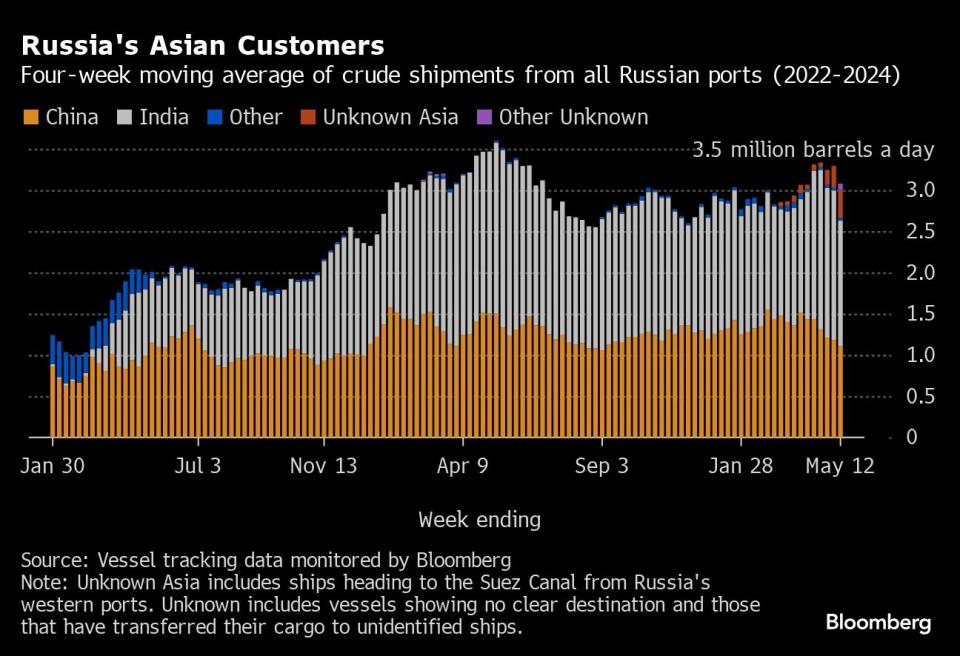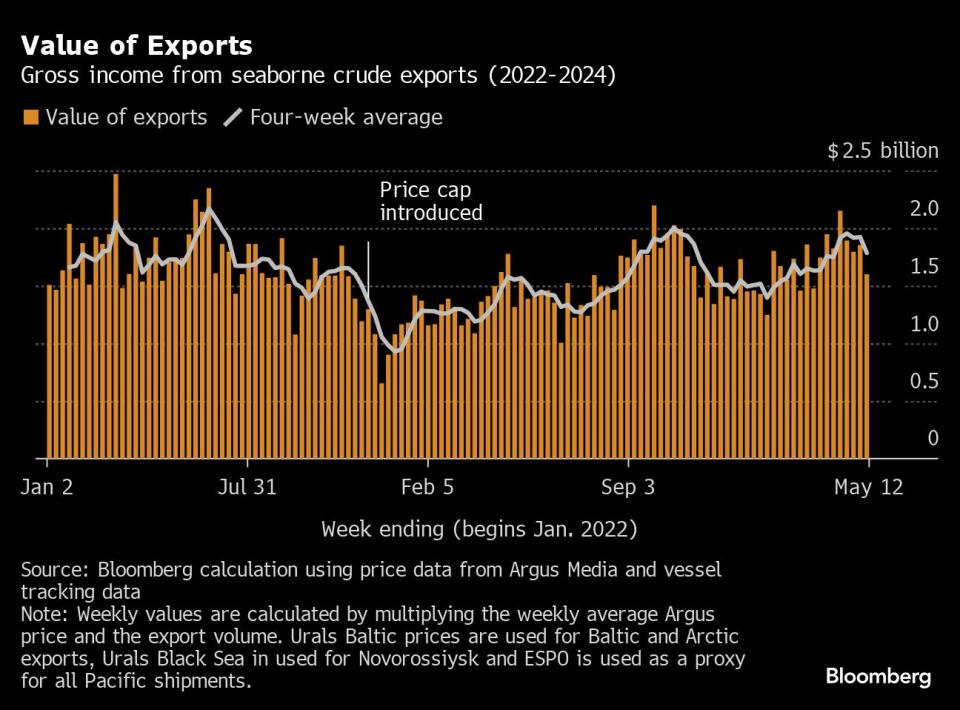Russia’s Seaborne Crude Exports Plunge to a Two-Month Low
(Bloomberg) -- Russia’s crude flows dropped to an eight-week low in the seven days to May 12, with fewer vessels leaving the major ports of Primorsk and Ust-Luga on the Baltic coast and from Murmansk on the Arctic. The four-week average also fell, dropping by the most in 10 weeks.
Most Read from Bloomberg
Flood of China Used Cooking Oil Spurs Call to Hike US Levies
Biden Accuses China of ‘Cheating’ on Trade, Imposes New Tariffs
Trump Vows ‘Day One’ Executive Order Targeting Offshore Wind
OpenAI Chief Scientist Ilya Sutskever Is Leaving the Company
Shipments from the Baltic terminals, which were in line with a partial loading program for May seen by Bloomberg, may reflect deeper output cuts promised by Moscow to its partners in the OPEC+ group of oil producers.
Weekly shipments were about 270,000 barrels a day below a target for this month that’s part of the OPEC+ alliance’s broader effort to curb supplies and support prices. The four-week average was about 10,000 barrels a day below target.
The Kremlin also agreed to make deeper cuts to oil production, trimming volumes to about 9.1 million barrels a day from April. Output was cut by about 150,000 barrels a day last month, according to figures published by the Organization of Petroleum Exporting Countries. Moscow still missed its goal though, pumping about 319,000 barrels a day more than agreed, according to Bloomberg calculations based on official Russian data.
Lower export volumes, together with a week-on-week decline in oil prices in the period to May 12, hit the value of Russia’s exports. The four-week average value of overseas shipments fell by the most since November.
The first sanctioned Russian tanker to load crude after being listed is now crossing the Indian Ocean. The SCF Primorye, cited by the US in October for breaching a Group of Seven price cap, loaded Urals at Novorossiysk on the Black Sea in late April and is now showing a destination of Singapore. It is most likely en route for China, whose ports have been more willing than those elsewhere to handle vessels owned by sanctioned entities.
If it is able to discharge its cargo without difficulty, it could pave the way for other sanctioned tankers owned by state controlled Sovcomflot PJSC to return to work. Until now, no other sanctioned Sovcomflot tanker has loaded a cargo.
The company has renamed and reflagged at least 10 of its 21 ships that have been listed by the US Treasury Department for breaching the price cap, perhaps with the intention of distancing them from the sanctions.
Separately, the Yasa Golden Bosphorus, which was removed from the sanctions list last month, has loaded a cargo of US crude at Houston.
Crude Shipments
A total of 30 tankers loaded 22.69 million barrels of Russian crude in the week to May 12, vessel-tracking data and port agent reports show. That was down by about 3.05 million barrels from the previous week.
Russia’s seaborne crude flows in the week to May 12 fell by about 440,000 barrels a day to 3.24 million, their lowest in eight weeks, from 3.68 million for the week to May 5. The less volatile four-week average was down by about 180,000 barrels a day at 3.48 million.
The drop was driven by fewer shipments from the Baltic ports of Primorsk and Ust-Luga and through the port of Murmansk on the Arctic. Baltic shipments are running in line with a partial loading program seen by Bloomberg, which shows a drop in Urals flows from their April level.
Crude shipments so far this year are running about 30,000 barrels a day below the average for 2023.
Russia said it would cut crude exports during April by 121,000 barrels a day from their average May-June level, while May shipments would be 71,000 barrels a day below the same starting point. Moscow is shifting more of the burden of its commitment to OPEC+ onto production targets, which are preferred by other members of the group. Seaborne shipments in the first three months of the year exceeded Russia’s target level for that period by just 16,000 barrels a day.
One cargo of Kazakhstan’s KEBCO was loaded at Ust-Luga and one at Novorossiysk during the week.
Flows by Destination
Asia
Most Read from Bloomberg
Observed shipments to Russia’s Asian customers, including those showing no final destination, fell to a five-week low of 3.08 million barrels a day in the four weeks to May 12, from 3.29 million in the previous four-week period.
About 1.11 million barrels a day of crude was loaded onto tankers heading to China. The Asian nation’s seaborne imports are boosted by about 800,000 barrels a day of crude delivered from Russia by pipeline, either directly, or via Kazakhstan.
Flows on ships signaling destinations in India averaged about 1.52 million barrels a day.
Both the Chinese and Indian figures are likely to rise as the discharge ports become clear for vessels that are not currently showing final destinations.
The equivalent of about 340,000 barrels a day was on vessels signaling Port Said or Suez in Egypt. Those voyages typically end at ports in India or China and show up as “Unknown Asia” until a final destination becomes apparent.
The “Other Unknown” volumes, running at about 80,000 barrels a day in the four weeks to May 12, are those on tankers showing no clear destination. Most originate from Russia’s western ports and go on to transit the Suez Canal, but some could end up in Turkey. Others may be moved from one vessel to another, with most such transfers now taking place in the Mediterranean, or more recently off Sohar in Oman.
Europe and Turkey
Most Read from Bloomberg
Russia’s seaborne crude exports to European countries have ceased, with flows to Bulgaria halted at the end of last year. Moscow also lost about 500,000 barrels a day of pipeline exports to Poland and Germany at the start of 2023, when those countries stopped purchases.
Turkey is now the only short-haul market for shipments from Russia’s western ports, with flows in the 28 days to May 12 rising to a six-week high of 396,000 barrels a day.
Export Value
The gross value of Russia’s crude exports fell to $1.6 billion in the seven days to May 12 from about $1.85 billion in the period to May 5. Four-week average income was also down, dropping by about $140 million to $1.79 billion a week. The four-week average peak of $2.17 billion a week was reached in the period to June 19, 2022.
A drop in the amount exported and lower prices week on week combined to drive oil revenues to an eight-week low. Four week average export value saw its biggest decline since November.
During the first four weeks after the Group of Seven nations’ price cap on Russian crude exports came into effect in early December 2022, the value of seaborne flows fell to a low of $930 million a week, but soon recovered.
NOTES
This story forms part of a weekly series tracking shipments of crude from Russian export terminals and the gross value of those flows. The next update will be on Tuesday, May 21.
All figures exclude cargoes identified as Kazakhstan’s KEBCO grade. Those are shipments made by KazTransoil JSC that transit Russia for export through Novorossiysk and Ust-Luga and are not subject to European Union sanctions or a price cap. The Kazakh barrels are blended with crude of Russian origin to create a uniform export stream. Since Russia’s invasion of Ukraine, Kazakhstan has rebranded its cargoes to distinguish them from those shipped by Russian companies.
Vessel-tracking data are cross-checked against port agent reports as well as flows and ship movements reported by other information providers including Kpler and Vortexa Ltd.If you are reading this story on the Bloomberg terminal, click here for a link to a PDF file of four-week average flows from Russia to key destinations.
--With assistance from Sherry Su.
Most Read from Bloomberg Businessweek
How the ‘Harvard of Trading’ Ruined Thousands of Young People’s Lives
US East Coast Ports Are Spending Billions to Profit From Asia’s Shifting Exports
Cheap Prison Labor Is Keeping People Locked Up Longer, Suit Alleges
©2024 Bloomberg L.P.










